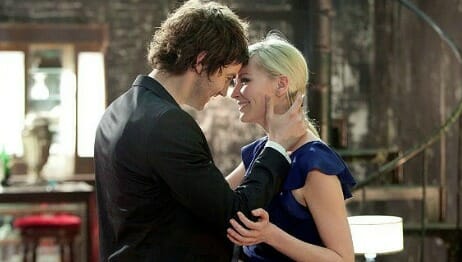
One of the basic tenets of screenwriting is to show, not tell. Upside Down violates this rule in the first minute, and it’s no wonder; the sci-fi romance from writer/director Juan Solanas is the epitome of high concept.
In a monologue overflowing with breathy, forced earnestness, our protagonist Adam (Jim Sturgess) explains the heady setup, which will likely have physicists running for the theater doors screaming or laughing or both. Imagine a universe with two Earth-like worlds stacked on top of each other—each world’s inhabitants can look up and see the others on their respective surfaces. All matter on each world is subject to the pull of gravity unique to its native world. Which means a spoon, a chicken, or even a person from planet A, if it somehow makes its way to planet B, will still be pulled “up” back to its home. Matter from the worlds can counteract each other’s weight to create a sort of floating, but only for a little while, as extended contact between the different matter will cause it to burn.
And thus, in record time, the film punches a gaping hole in its own premise. As a kid, Adam has a meet-cute with Eden (Kirsten Dunst), who is from the other world, while both are exploring almost-touching mountain peaks near their country homes. With some strategic lassoing they rendezvous in secret. But according to their own laws of inter-world physics, how can they possibly do anything other than smile and wave at each other without literally getting hot? Suspension of disbelief is one thing; it’s another entirely to take great pains making up and explaining rules you then violate.
The idea of lovers from different worlds is already a little on the nose, but there’s also an economic element to further hammer the idea home, in the form of the TransWorld company—a monolithic corporation that’s aggressively harvested the resources of Adam’s world, rendering it decrepit and impoverished. (Eden’s, by contrast, is sparkling and affluent.) The main headquarters stands as the sole physical connector of the two worlds, an imposing structure that houses a special office space in the middle for workers from both, with cubicles on the ceiling and the floor.
Adam thinks Eden had died after one of their childhood trysts ended in an accident ten years past, but he finds out she merely suffers from amnesia, and now works for the upper-class management section of TransWorld. Adam gets a job there and enacts a plan involving shoving “inverse matter” weights into his clothes to infiltrate the upper floors to see Eden and reignite her memory.
The film certainly looks pretty. The swirling clouds, mirrored mountaintops, and vast inverted cityscapes are appropriately fantastic in design and scope, like something conceived by one of the dream architects in Inception. But it’s all window dressing.
What’s so frustrating is that the core idea is intriguing, but it’s been hijacked and ruined by a script, and maybe even a sub-genre, that doesn’t know how to treat it properly. The wasted concept overwhelms all other aspects of the production—an otherwise bare-bones soap-opera romance between completely undeveloped and uninteresting characters.
Here’s a sample of the cracking dialogue, emblematic of the entire tone. One of Adam’s friends admonishes him that “You’ll never have a chance with her! She’s from up there, don’t you get it?” That’s a slight paraphrase. But then, Upside Down feels like a paraphrase of a much better movie.
Director: Juan Solanas
Writer: Juan Solanas
Starring: Kirsten Dunst, Jim Sturgess, Timothy Spall
Release Date: Mar. 15, 2013